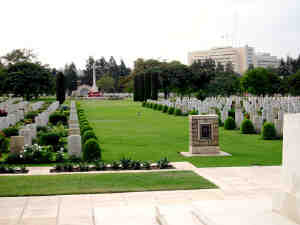Norman Hardman (Nim) Glasson
- Born: 24 Mar 1916, Carcoar, NSW Australia
- Died: 27 Oct 1942, North Africa at age 26
- Buried: Heliopolis War Cemetery, Cairo Egypt
Cause of his death was from war wounds.
General Notes:
Stephen Crawshaw notes:
Wounded in battle before El Alamein and died during operation six weeks after shrapnel wound which had caused loss of eye(s). Army says "Died of Wounds, Egypt, 27/10/42".
Account by sister Bessie:
When France fell, things looked pretty grim for Britain and her allies. Ian and Nim, who until then had been working in 12 hour shifts to keep farm production at the maximum for the war effort, decided one of them should enlist, while the other remained at home to keep the farm producing. They tossed and Nim won, so he was the one who enlisted. He was in the 3rd Anti Tank Regiment, Royal Australian Artillery, 9th Division, 2nd AIF. His Number was NX50954. The copy of the "Honour Roll" lists his rank as Gunner [artillery equivalent of Private] but the certificate from the War Memorial lists him as Sergeant. He was wounded during a battle just prior to the Battle of El Alamein when he raised his head from the bunker [not tank] before giving the order to fire. Shrapnel passed through the bridge of his nose, taking out one eye and damaging the other. A mate told us afterwards that it also smashed his jaw, but Nim didn't want his family worried about that. We had to be told about his eyes because he could not see to write properly. He is listed as "died of wounds". He had the choice of coming home on a hospital ship with some of his wounded mates, but chose to stay for one more operation, to be performed by a well-credentialled Harley Street eye specialist. He died on the operating table, on Tuesday, 27th October, 1942. He is buried in Heliopolis War Cemetery. During his first overseas trip, Ian visited the grave. I can imagine how terrible it must have been for him. One of Nim's best mates told me that he thought that Nim had lost the will to live. He knew he would be blind or nearly so, and didn't want to be a burden to others. There have been medical and social advances since then, but blindness must still be a dreadful handicap.
Ian and Nim were always dear to me when I was growing up. Both were outstanding athletes at school, both had a well-developed sense of humour and both helped with my "education". Of course they teased me a lot, but Ian patiently answered my endless questions and Nim spent hours trying [unsuccessfully I might add] to teach me ball skills. They read books to me and told me tall stories, as well as vivid versions of bible stories, to keep me entertained. [2003]
From Commonwealth War Graves:
In Memory of
Sergeant NORMAN HARDMAN GLASSON
NX50954, A.I.F. 3 A/tk Regt., Royal Australian Artillery
who died at age 26 on 27 October 1942.
Son of John Henry and Katie Maud Glasson, of Carcoar, NSW, Australia.
Remembered with honour
HELIOPOLIS WAR CEMETERY
Location: Heliopolis, a major suburb of Cairo, lies 10 kilometres to the north-east of the main city centre, approximately 6 kilometres from the airport. Heliopolis War Cemetery is situated opposite El Banat (Girls') College in Nabil el Wakkard Street, and access to the cemetery is from this street. On the rear boundary of Heliopolis War Cemetery will be found the Heliopolis (Aden) Memorial, commemorating the Aden Field Force and sailors and soldiers who fell in the defence of Aden in the 1914-1918 War, and who have no known grave. Also within Heliopolis War Cemetery, on panels erected in the entrance pavilion, is the Heliopolis (Port Tewfik) Memorial commemorating the Indian dead of the Great War in Egypt and Palestine.
Historical Information: When the 1914-1918 War broke out, Cairo was the headquarters of the British garrison in Egypt, and the principal military hospital was in the Citadel. The city became a main hospital centre for Gallipoli in 1915, and throughout the war dealt with sick and wounded from the army in Egypt and later in Palestine. General Headquarters, Middle East Command, set up in Cairo shortly before the 1939-1945 War, remained there all through the war years; and in January 1941 the Royal Air Force Sector Headquarters for Fighter Defence Canal Zone was set up. The Second World War saw Cairo again a hospital centre. A very large number of nationalities were represented in the Middle East Command. All had their own standards and required as far as possible to be tended in their own hospitals, by medical staffs speaking their languages. The Command included labour units recruited in the countries in which British forces were operating \emdash Palestine, Syria, Iraq and Persia (now Iran); from colonies such as Mauritius and the Seychelles; from Malta and Cyprus, from Basutoland and Bechuanaland; and from East and West Africa. Troops from the Dominions and India, and those of the allies \emdash Poles, Free French, Czechs and others \emdash all had to be provided for separately. Cairo was also a leave centre, and many soldiers' clubs and hostels were created to supplement the entertainment resources of the city and to provide cheap accommodation. Heliopolis War Cemetery was opened in October 1941, and took casualties from the many hospitals established in the Western Desert campaigns. After the war 125 Moslem graves were moved to it from Mena Camp Military Cemetery, which was so situated that permanent maintenance was not possible. There are now 1742, 1939-45 Commonwealth war casualties commemorated here, 4 of whom are unidentified.
|

